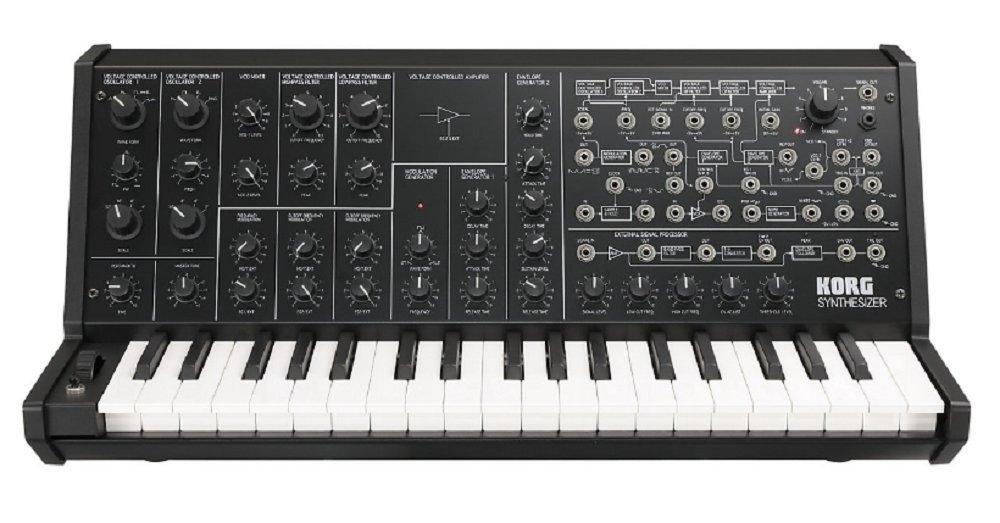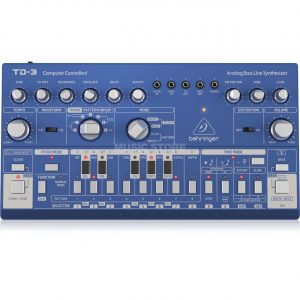Korg MS-20 Mini
$386.99
Feel the iconic sound of the legendary Korg MS-20 Mini synthesizer, renowned by generations of musicians for its immense power and flexibility.
Compare
Description
The Korg MS-20 Mini Synthesizer is a modern reissue of the iconic MS-20 synthesizer, originally introduced in 1978. The MS-20 was one of the first affordable synthesizers to feature patchable signal routing, allowing musicians to create complex sounds by combining the instrument’s various components together.
The MS-20 Mini includes many of the same features as the original, including two oscillators, two envelope generators, a filter, and a patch panel for signal routing. However, the MS-20 Mini is smaller and more compact, making it easier to transport and use in a home studio or live performance.
One of the most notable features of the MS-20 Mini is its patch panel. The patch panel allows musicians to connect various components of the synthesizer together to create unique sounds. For example, you could connect an envelope generator to the filter to create a sweeping sound, or connect an LFO to the oscillator to create a pulsing effect.
The MS-20 Mini also includes a variety of other features that make it a versatile and powerful synthesizer. It has a built-in sequencer, which can be used to create complex polyrhythmic patterns. It also has a built-in MIDI/USB interface, allowing it to be easily integrated into a digital audio workstation or used with other MIDI devices.
In terms of sound quality, the MS-20 Mini is a faithful reproduction of the original MS-20. It has a distinctive, raw sound that is perfect for creating gritty basslines, piercing leads, and other unconventional sounds. The filter is particularly notable, offering a range of different tonal options that can be used to shape your sound.
Overall, the Korg MS-20 Mini Synthesizer is an excellent choice for anyone who is interested in exploring the world of analog synthesis. Its compact size, flexible patch panel, and powerful sound engine make it a versatile instrument that can be used in a wide range of musical styles. So, if you are a beginner or a professional musician, the Korg MS-20 Mini Synthesizer is worth considering for its impressive sound and versatility.
Korg MS-20 Mini properties
| Product name |
MS-20 Mini |
| Brand |
Korg |
| Type |
Keyboard Instruments |
| Keyboard Instrument |
Synthesizer |
| Rotary Controls |
Yes |
Frequently Asked Questions:
How can I adjust the filter cutoff frequency on my Korg MS-20 Mini synthesizer?
To adjust the filter cutoff frequency on your Korg MS-20 Mini synthesizer, follow these steps:
1. for a low-pass filter, press and hold the parameter button (normally set to + or -) while turning the filter knob. For a high-pass filter, turn the filter knob until it reaches the desired cutoff frequency.
2. If you're using an aftermarket filter module, refer to the manufacturer's instructions for adjusting the cutoff frequency.
3. If you want to store your filter settings as preset parameters, assign them to individual preset parameter slots on your MS-20 Mini synthesizer. To do so, hold down the parameter button and select the desired preset parameter slot while turning the filter knob to adjust the cutoff frequency.
4. Finally, make sure that the Korg MS-20 Mini synthesizer is properly calibrated by following any calibration procedures provided by Korg. Improper calibration could result in incorrect filter cutoff frequencies.
How do I properly calibrate and adjust the oscillator and filter settings on a Korg MS-20 Mini to achieve optimal synthesis results?
To properly calibrate and adjust the oscillator and filter settings on a Korg MS-20 Mini for optimal synthesis results, follow these steps:
1. Power on your MS-20 Mini and ensure it is in the "Perform" mode. If you are unfamiliar with this mode, refer to the user manual for instructions. Set the oscillator frequency to a low value, such as 50 Hz. This will allow you to hear any issues with stability or drift in the oscillator's output. Adjust the oscillator's waveform by turning the SHAPE knob. Try each of the available waveforms (triangle, sawtooth, pulse) and listen for differences in timbre and stability. Choose the one that sounds most stable and has a clean, accurate waveform. Increase the oscillator's frequency to a higher value, such as 1 kHz. This will allow you to hear any issues with harmonic content or noise in the signal. Adjust the resonance on the low-pass filter (LPF) by turning the RES knob. Try both high and low values of resonance, and listen for differences in timbre and stability. Choose the one that sounds most stable and has a clean, accurate signal. If necessary, adjust the cutoff frequency of the LPF by turning the CUTOFF knob. Try different values and listen for differences in tonality and stability. Choose the one that sounds most stable and has a clear, focused sound. If you are using multiple oscillators or voices, ensure they are phase-aligned by adjusting their fine-tuning settings (if available). This can prevent phasing or other unwanted artifacts in the signal. Test your synthesis setup by playing a simple melody or chord progression. Listen for any issues with stability, tonality, or harmonics. Adjust the oscillator and filter settings as necessary to achieve optimal results. Remember to save your settings using the "Store" function (if available) so you can easily recall them later. And always take care to properly power off and store your MS-20 Mini when not in use, to prevent damage or drift in its circuitry.
What are the key differences between the original Korg MS-20 and its miniaturized version, particularly in terms of tone and functionality?
The original Korg MS-20 and its miniaturized version, known as the MS-20 Mini, share many similarities but also have some notable differences. The most obvious difference is the size, with the MS-20 Mini being a more compact unit that still retains all of the same functionality as the larger model. One key difference between the two units lies in their tone and timbre. The original MS-20 is known for its rich, full-bodied sound, which is due in part to its analog circuitry. The MS-20 Mini also uses analog circuitry, but it has a slightly brighter and more aggressive sound compared to its larger counterpart. Another difference between the two units lies in their functionality. While both units have all of the same controls and features as each other, the MS-20 Mini is designed to be more user-friendly and accessible for beginners. The miniaturized unit also lacks some of the external jacks found on the original MS-20, such as the pitch CV input and the gate CV output. The MS-20 Mini also has a slightly different layout compared to the original unit. The miniaturized version has a more compact design, with all of the controls and features consolidated into a smaller space. This can make it easier to use and navigate for those who are new to synthesizers or analog equipment in general. In terms of build quality, both units are well-made and durable, but the MS-20 Mini is made from a slightly lighter material than its larger counterpart. However, this does not affect the unit's performance or sound quality in any way. Overall, while there are some key differences between the original Korg MS-20 and its miniaturized version, both units are capable of producing high-quality sounds that can be used in a wide range of musical applications. The choice between the two ultimately comes down to personal preference and specific needs.
Before you buy Korg MS-20 Mini








Nathaniel Jarvis –
The instrument sounds nice, but the performance is not the best (plastic) The most annoying, however, is the idiotic operation 3 hours I had to deal with such a simple thing (in other instruments) as writing the edited melody in the sequencer.
Another half a hour I was looking for the option to erase the sequencer memory (the manual is sorry God – only 70 pages describing the basic functions) Generally for live play OK – everything else is DRAMAT and the road through the torment. I read on the forum say one donkey who wrote that after an hour he supposedly knew everything on the key without looking at the instructions. AKURAT !!! Bedtime stories for children.
Paul –
Hi, my name is Paul and I recently purchased a Korg MS-20 Mini from an online shop during my vacation. I must say, I am extremely pleased with my decision. The Korg MS-20 Mini is a versatile and powerful synthesizer that has exceeded my expectations.
In terms of its amateur use, the Korg MS-20 Mini is perfect for beginners who are just starting out in the world of synthesizers. It offers a user-friendly interface and intuitive controls, making it easy for anyone to grasp the basics of sound synthesis. The built-in patch panel also allows for experimentation and exploration, encouraging creativity and learning.
On the other hand, the Korg MS-20 Mini is not limited to just amateur use. Its professional capabilities are truly impressive. The sound quality is exceptional, with a rich and warm tone that can rival many high-end synthesizers. The flexibility of the patch panel allows for complex and intricate sound shaping, making it a favorite among professional musicians and sound designers.
One of the aspects that make the Korg MS-20 Mini stand out is its brand, Korg. Korg is synonymous with quality and innovation in the world of music technology. Their years of experience and expertise are evident in the design and functionality of the MS-20 Mini. The brand’s reputation for reliability and durability only adds to the value of this synthesizer.
Overall, I couldn’t be happier with my purchase of the Korg MS-20 Mini. It has proven to be a fantastic addition to my music setup, both in terms of its amateur-friendly features and its professional-grade capabilities. The Korg brand has once again delivered a top-notch product that has exceeded my expectations.